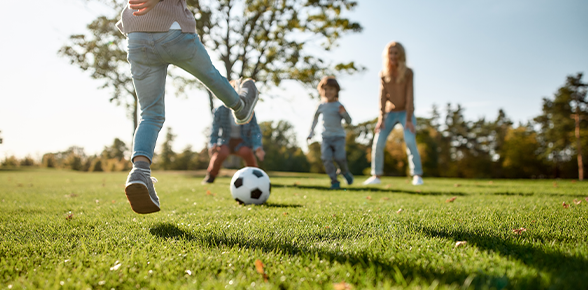If potty training is not going as well as you’d hoped, don’t worry. Potty training problems are pretty common, with many children taking between three to six months to become toilet experts.
Whether they’re not making it to the potty fast enough, don’t want to go, or simply aren’t aware they’ve had an accident, as a parent you should always remain calm – even if it’s the third accident of the day.
It may well be that it’s too soon and they aren’t quite ready – this is fine. Most parents start when their child is between two and two and a half. But as you’ll know, children develop at different times, so the right time to start potty training differs, too. Knowing the various hurdles you could face and, more importantly, how to tackle them will make things easier and less stressful for both you and your child.
This article will cover:
- How to persuade your child to use the potty if they are refusing
- Accidents and how to deal with them
- Anxiety and regression during potty training
We all know that when kids don’t want to do something, it can be hard to negotiate with them. We look at some of the reasons why your little ones refuses to get on board with toilet training – from how to get a stubborn four-year-old to poo in the potty to wanting your two-year-old to sit on the potty for the first time.
Refusing to use the potty
If your little one is out and out refusing to even go near the potty, then maybe they’re just not ready yet. You can try some gentle persuasion, but if they still refuse to give it a go then maybe wait a month or so and try again. Keep an eye out for the signs your child is ready, which will include:
- Remaining dry for two hours
- Hiding when pooing
- Telling you when they have been to the toilet
- Asking about the potty
- Insisting on a change when a nappy is soiled
Refusing to poo in the potty
Getting your child to do a wee on the potty is a great start - but if your child won’t poo in the potty then you still have a little way to go on your toilet training journey. This is very common and can take time.
Sometimes, they just need the right encouragement and motivation. Potty training reward charts can help with this, giving them a record of their successful toilet trips.
Another reason kids can be reluctant to poo in a potty or toilet is that they are scared of the actual poo. Help them overcome this fear by emptying their nappy together into the toilet. Have them wash their hands when they have been to show that it is fine. Whether they poo or not, make sure you praise them for doing a wee or even just sitting on the potty.
Refusing to stay on potty and finish
Many kids find it hard to sit still at the best of times – and this can be even trickier when on the toilet. Firstly, you should aim to keep them there for a couple of minutes to make sure they’ve completely emptied their bowels.
If they haven’t gone by then, leave it for now and try again later. Try making toilet trips fun to keep them glued to their seats - especially if they are easily distracted. Keeping a book by the potty is a great tip – there are plenty of entertaining reads about using the potty that could help them.
Also, if they’re in the middle of playing reassure them their toys aren’t going anywhere. For those with siblings, make sure everyone stops playing during the toilet break.
Accidents when potty training
It may feel like potty training is not going well if your child is having accidents, but many children do. You just have to persevere because they will get it eventually.
And perseverance is key. Don’t keep starting and stopping potty training– you will only confuse your child. If after a few days or a week you feel like you want to stop, then return to nappies and leave it for a few weeks before you try again.
Whether your potty training problems are with poo or wee, you need to be prepared to be changing and washing clothes regularly. Remember, your little one hasn’t done this on purpose - so don’t pressure them or tell them off for it.
An accident can be very upsetting for your child - and you don’t want to make them feel even worse. Instead, praise them for the times they have stayed dry and remind them that next time they should go to the potty. Ultimately, this may also make potty training take longer than you’d planned.
You may also want to increase the number of times you’re asking your child whether they need to go to the toilet and encourage them to tell you when they do. Make sure you keep an eye out for signs that they look like they need to go and take them to try, just in case.
Potty training stress and anxiety
Potty training anxiety in toddlers is common, especially when they start using a real toilet. Remember, it’s a brand new experience for them –and while some will take to it easily, others may feel wary and take time to understand that it isn’t as daunting as they first thought.
During potty training, children could be scared of:
- Going on toilets – if your child is scared of using a toilet, use a training seat and stool to make it easier to use. Talk about the toilet positively and perhaps even let them see you use it, so they know that it’s something everyone does.
- Using public toilets – even if your toddler uses the toilet at home, they may be scared of public toilets. They’re unlikely to feel as safe and comfortable as they do in their own house. Keep the whole experience as similar as possible - perhaps by taking the book that they have been reading with you. Talk them through the situation, explaining any differences such as hand driers, cubicles and urinals.
- Noisy flushing – the sights and sounds of a toilet flushing can be scary to a little child. Some children even fear they’ll be sucked into the toilet. If this sounds like your little one, start by flushing the toilet when they have left the room. Then, do it while they are in the room but distracted. You could also let your child flush themselves, so they can see that it isn’t scary at all.
- Seeing poo in toilet or potty – some potty training stress comes from children seeing their poo in the toilet or potty. This isn’t something they’ve seen before and watching it be flushed away can be scary to them. Explain to your child what it is and why we go to the toilet – and where it goes. You could also encourage them not to look and close the lid once they have been.
Potty training regression
It’s a few weeks into toilet training and things are going well. But then suddenly, they’re not. Accidents start happening again or your little one has decided they don’t want to use the potty anymore. Potty training regression can be frustrating. Stay calm, you know they can do it - it might just take a little longer than you were hoping.
Here’s how to handle potty training regression.
Intentional regression – do you have a four year old wetting themselves on purpose? Try not to be angry. There will be a reason your child is doing this. This could be them seeking more of your attention. Or it could be a big change in their life such as starting a new group in nursery or going to school. Deal with the cause, not the outcome. If it’s not obvious, talk to them and ask why they are doing it - make sure you take time to explain to them that they were doing so well and keep it positive. Start a new reward system to encourage them to get back on track.
Accidental regression – any change can have an emotional impact on a child and this could be the result. If you can put your finger on a reason, then make sure you are dealing with this. But, your child may just need a gentle reminder about what they need to do. Accidental regression could mean there’s something wrong such as a bladder infection. If this continues to happen and you think this could be the case, make sure you speak to a doctor.







